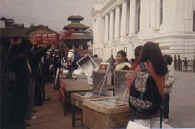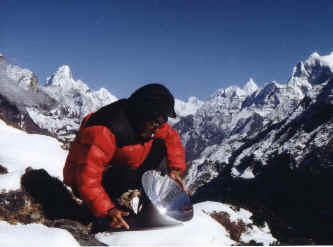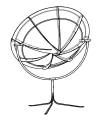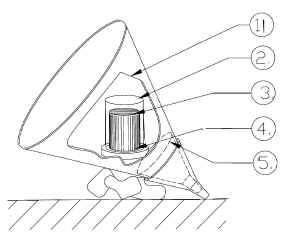solar cooking dissemination approaches and
experiences in nepal, mongolia and peru
paper presented at the 8th peru international symposium of solar energy, national university,
universidad nacional del altiplano , puno, peru,
allart ligtenberg
fast (friendly appropriate solar technologies)���������
800 loyola drive, los altos, california, 94024, usa
tel/fax:� (650)948-8294��������� �
e-mail:� aligtenber@aol.com ����� ���������� http://www.bali-i.com/fast-solar
purpose of work:
to teach, disseminate, and promote solar cooking (and solar water pasteurization and drying) in nepal, then in mongolia and peru. to provide solar technologies research and technology transfer. to initiate new programs. to overcome cultural barriers to solar cooking.
my work started in 1992, when i retired from hewlett packard comp where i was engineering manager. this allowed me to follow my dream to disseminate solar cooking in nepal (and more recently in other developing countries). i choose nepal because my frequent visits and solo-treks there during the past 21 years have sensitized me to the environmental deterioration, affecting the himalayan region. rapid growth in population and tourism has increased demands on a very delicate environment. scarce natural resources such as fuelwood, which provides almost all of nepal's energy needs, are being depleted rapidly. smokey fires cause lung and eye problems. solar cooking can significantly help decrease the very critical health and environmental problems of the country. in 1992 solar cooking and solar water pasteurization was not being practiced. my objective was to build a sustainable solar cooking program and search for a local organization that would be interested to �champion� this cause. i follow up each year for three months to insure success and start new initiatives.
solar dissemination strategy:
my approach to dissemination and promotion of solar cooking is very simple: talking to as many people and organizations as possible, anywhere and any time. these discussions can be at different levels of the simplified "a b c's" of dissemination:
awareness creation, building the infra structure, continuous follow-up and creating new links.
it is absolute key to first identify a local �champion� organization one can work with.
approaches and experiences in nepal:
� identify and work with organizations where solar cooking would be a natural addition to programs such as renewable energy, environment, health, women empowerment, etc :
they include ngo's (non government organizations) at the multi-national, national, regional, urban, rural, and mountain area levels. i also pursued embassies/consulates, universities, colleges, schools, small businesses, service organizations, and government.
after meeting with many agencies in 1992, i was very happy to finally find the receptive crt (centre for rural technology) organization in kathmandu. it helped that i brought with me 2 types of solar cookers, plus materials from solar cookers international (sci), manuals on �how to make and use solar cookers�, recipe books, photographs of different cooker types used in multiple countries, proceedings of sci�s international conference on solar cooking, and other publications. off course building some cookers, preparing and tasting solar food, and discussing the principles and advantages are all part of the process. since then, i have worked with crt to initiate and develop a solar cooking program that will provide the necessary education and outreach to disseminate this technology.� crt is a very capable, professional, well-connected ngo, with experience in transferring new technologies into rural areas. solar was added to their existing programs in water mills, micro-hydro, chulo ovens, biogas, forestry and agriculture. crt has made significant progress over these last 8 years. i consider them the "champion" of solar cooking in nepal.

� awareness creation of solar cooking uses and technologies - through discussion meetings, demonstrations, food tasting, literature handouts, workshops, pilot projects, radio/tv broadcasts and newspaper articles:
ngo�s, community leaders, environmentalists and scientists became familiar with the technology and its advantages. as a result a number of organizations sent their representatives to workshops conducted by crt. in four-day workshops (fig 1, 1993) on "how to build and use solar box cookers and how to pasteurize water", each participant built 2 cardboard box cookers. the participants developed action plans to teach and spread solar cooking in their respective villages and projects. in later years the wooden box cooker and parabolic solar cooker were introduced into the workshops. we developed cookers made out of local materials and readily available household items. recipes were adapted to accommodate local food customs.
� teaching water pasteurization principles:
disease microbes and fecal contamination in drinking water are the major cause of disease in the developing world. it is not a well-known fact that bringing contaminated water to pasteurization temperature (65 degree celsius) for 5 minutes is sufficient to kill all microbes (see ref 1 and 2). boiling is not really necessary and requires more then double the amount of energy. a wapi (water pasteurization indicator), made out of a polycarbonate tube partially filled with soybean fat that melts at 68 � c can detect that water is safely pasteurized. each time i came back to nepal i brought some wapi�s and a set of 100-200 test tubes donated by idexx laboratories (ref 3). these test tubes contain pre-dispensed reagent colilert that can detect coliform and fecal e-coli contamination.� after filling the 10 ml test tubes with sample water, one keeps the tubes in the dark at body temperature under ones clothes for 24 hours. if coliform bacteria are present, the water will become yellow. otherwise it will remain clear. if e-coli is among the coliform bacteria present, the tube will fluoresce blue when a battery-operated, ultraviolet light shines on it, indicating fecal contamination.
�� i have used this method for very simple field testing of water in streams, lakes, watertaps, and ground water. during workshops i demonstrated successful pasteurization by heating contaminated water inside the solar cooker to over 65 degrees celsius and through subsequent coliform testing.
over the years i have distributed these colilert mpn test tubes to st.xavier college, the nepal liver foundation (nlf), crt and workshop participants. students and professors at the college did surveys and reports of water quality in the valley. the nlf is using the test tubes in a public health education project to teach water pasteurization and combat the waterborne hepatitis e virus epidemics.
 �
public solar cooking
demonstrations:
�
public solar cooking
demonstrations:
a major step forward in creating awareness with the public occurred in 1993 when we expanded the demonstrations at crt to an open public solar demonstration at the busiest square in kathmandu (fig 2). on the basantapur durbar square, we cooked food in 11 box cookers (wood, cardboard, bamboo, metal, and fiberglass), a large parabolic cooker, and a small backpack cooker. an estimated two thousand people showed such tremendous interest, that crowd control was sometimes difficult. we had tv coverage on the evening news and newspaper coverage for days. from then on, these public awareness campaigns were successfully repeated all over cities in the kathmandu valley.
� light-weight backpack cooker, an effective solar demo tool:
to demonstrate and teach solar cooking while trekking in remote areas, i designed a portable cooker (400 grams) in 1993 that cooked efficiently. i had it with me at all times.
figure 3 shows the various parts of my one-person cooker
1. cone-shaped (roll-up) reflector, made of 85-90 % reflective aluminum coated plastic.
2. glass light fixture or jam jar, placed over the can contains the heat.
3. aluminum beverage can with lid, painted black is the "cooking pot".
4. disk to horizontally support the glass enclosed container.
5. two funnels hold the reflector.
assembling and focusing the cooker is easily done in less than a minute. one focuses the cooker by pointing the reflector to the sun and sticking the funnel into the ground or supporting the cooker (at the proper angle) with some rocks. cooking times are less than 40 minutes for rice, 20 minutes for soups, tea and pasteurized water. renewed focusing is not necessary. i prepare solar rice, lentils, potatoes, dal-bhat, tea and hot lemon. after cooking, the reflector can roll up into a compact cylinder.
� trekking experiences to the annapurna, everest, ganesh himal, langtang, helumbu/gosainkind mountain areas:
half of my time in nepal is spent on solo-treks to remote mountain regions to: disseminate solar cooking, document the environmental deterioration, find potential champions to start a program, and refer people to crt. i also put in an effort to influence individual trekkers and agencies to behave in an eco friendly manner with respect for nepalese culture and fragile environment.
my two treks to the annapurna region resulted in projects with a lodgekeeper in braga, the acap visitor center in manang, and approval of solar by head lamas in five monasteries (ref 4). in acap (annapurna conservation area project) sites in jomsom and kagbeni i demonstrated solar for project staff, local groups, tourists, and pilgrims. in the village of marpha, it was gratifying to see many solar dryers in use during the apple season. talks with community leaders showed real interest in adding solar cooking; this confirms my view that solar cooking will be more easily accepted when solar dryers are common practice. in the pokhara valley, acap headquarters saw potential for solar in their environmental and tourist education programs. most trekkers drink bottled water from plastic bottles and throw them away, causing unsightly garbage problems. prohibiting their use and replacing them with solar pasteurized water would solve part of the problem. at the institute of appropriate technology, we discussed adding fabrication of solar waterheaters and cookers to the curriculum.
in two treks to the langtang area i documented (ref 5): 1) the disappearance of a large forest with monkeys and birds, 2) landslides caused by deforestation, 3) global warming - glaciers on steep mountain faces disappeared, proven by overlaying old/new photo's, 4) water pollution of high-altitude lakes and streams, 5) health problems caused by open-fire cooking and contaminated drinking water.
ganesh himal and helumbu treks: care and save the children/us projects sites became interested enough to propose solar cooking/drying/water pasteurization to their nepal headquarters.
 three treks to the
everest area: many solar
cooking demonstrations with sagarmatha national park warden/staff, the park
museum, sherpa cultural centre, himalayan rescue association (hra) hospitals,
world wildlife fund (wwf), sagarmatha pollution control committee (spcc), and
lodges on the trail. in namche bazar i installed a solar dryer. at the sherpa
cultural centre, a solar box cooker donated a few years ago got resurrected;
the lodgekeeper is now using it. i convinced doctors at the hra hospital in
pheriche to use their solar cooker more often, so the local population would
see it used by respected �westerners�. the hra doctor in kunde felt that
building a solar water heater could enhance hygiene and solar education. wwf
has now added solar dryers to their greenhouse program. the rimpoche of the
tyangboche monastery agreed to get solar cookers. his blessing on solar would
greatly help advance the solar cause with the buddhist population of the
area.�
three treks to the
everest area: many solar
cooking demonstrations with sagarmatha national park warden/staff, the park
museum, sherpa cultural centre, himalayan rescue association (hra) hospitals,
world wildlife fund (wwf), sagarmatha pollution control committee (spcc), and
lodges on the trail. in namche bazar i installed a solar dryer. at the sherpa
cultural centre, a solar box cooker donated a few years ago got resurrected;
the lodgekeeper is now using it. i convinced doctors at the hra hospital in
pheriche to use their solar cooker more often, so the local population would
see it used by respected �westerners�. the hra doctor in kunde felt that
building a solar water heater could enhance hygiene and solar education. wwf
has now added solar dryers to their greenhouse program. the rimpoche of the
tyangboche monastery agreed to get solar cookers. his blessing on solar would
greatly help advance the solar cause with the buddhist population of the
area.�
solar lunches were even cooked, and snow melted on mountaintops up to 5800 meters (fig 4).
in the spring of 2000 i installed a collapsible, parabolic solar cooker (1-meter) at mount everest base camp for use by the �everest 2000 environmental cleanup expedition�.
�
 promote simple solar dryers/water-heaters
(serving as �stepping stones� to cookers):
promote simple solar dryers/water-heaters
(serving as �stepping stones� to cookers):
solar dryers and water-heaters are more easily accepted and can serve as stepping stones towards similarly built solar cookers. they do not have the cultural barriers to overcome, that solar cookers experience. crt provides workshops on solar drying (fig 5); a number of different low-cost models are available. people like the better quality (no insects, dirt) of dried fruits and vegetables, and the higher speed in a solar dryer, as compared to drying in the open air.
a solar dryer resembles a solar box cooker if its holes are closed up and insulation is added. it will be a smaller step intellectually and culturally to accept a solar cooker. last year i worked with a local solar dryer manufacturer to design a solar dryer/cooker for a cost-effective dual-use product.
� create links between different organizations:
when disseminating solar technologies i also promote crt�s capabilities. i encourage linking up with crt and expanding this into a collaborative working relationship. sometimes it helps if a knowledgeable �outsider� recommends to incorporate solar programs or to work with crt. examples are save the children (stc-uk and us), netherlands� and belgian consulates, us peace corps, varja foundation, acap, local ngo�s i had met on my treks.
� set up new ngo organization dedicated to disseminate only solar technologies:
in the spring of 2000 i helped with initiating an ngo, called pecon, whose sole aim is to conduct programs in solar cooking, drying, water pasteurization, space heating, and photo-voltaics.�
�
 follow up with the
organizations year in and year out:
follow up with the
organizations year in and year out:
continuous follow-up is very important. every year when i return, my �home base� is crt. all the other organizations i dealt with in the past will be visited, as well as new ones. we exchange ideas and pursue additional initiatives and projects: this resulted for example in a rural pilot project with stc-uk (fig 6). i give lectures. i discuss solar with as many individuals and organizations as possible.
the internet has made it possible for the last 2 years to communicate when i am not in nepal.
�
 design a powerful,
collapsible, light-weight parabolic solar cooker for trekking agencies:
design a powerful,
collapsible, light-weight parabolic solar cooker for trekking agencies:
this would promote responsible eco tourism and minimize environmental deterioration. trekking groups and expeditions would automatically disseminate solar cooking, providing a nice multiplier effect. fig 7 shows my design of the 1-meter (39�) diameter cooker with frame. it disassembles quickly in a handy package. the expedition leader of the year �2000 us everest environmental cleanup expedition� approved use of the cooker. so in the spring of 2000 i installed the �everest� parabolic solar cooker at mount everest base camp for their use (fig 7 a,b,c,d), while they cleared the mountain of 600 discarded oxygen bottles and other trash.
taan (trekking agencies association nepal) and the department of tourism started to see the eco tourism advantages of (portable) solar cookers that can preserve the environment and treat the water.
results in nepal: awareness of solar cooking has been raised significantly. the number of solar cookers has grown from zero to over 3000 since the start of the program in 1992. a reasonable infrastructure has been built. a number of organizations have taken solar cooking/drying/water pasteurization into their programs, actively promote it, and give workshops. small-scale manufacturing is taking place in the kathmandu valley as well as the bhutanese refugee camps in east nepal. a number of schools, colleges and universities teach solar and provide hands-on workshops.
nepal tv featured solar cooking as part of a science program series.
the government started a 50 % subsidy for solar cookers in 1998.
approaches and experiences in mongolia:
in 1998 the netherlands government�s nmcp (netherlands management cooperation program) asked me to conduct a 2 1/2 months mission to mongolia, to help a local company abe. i am registered in nmcp�s experts� database as a volunteer expert in solar technologies and business management. abe produces solar electric pv (photo-voltaic) home systems to be used by the nomadic peoples in their gers/yurts (circular tents). abe also became interested in other appropriate technologies, such as straw-bale housing, solar cookers/dryers/waterheaters.
my approaches were quite similar to those outlined for nepal. one needs to be flexible in adapting them to the culture and opportunities in mongolia. i used an additional approach very successfully:
� website search for organizations/people interested in renewable energy, environment, health:
through the internet i befriended 2 individuals at undp and peace corps in mongolia. on my arrival in ulaanbaatar they introduced me to important contacts in a very active development community. immediately i could be much more efficient in finding opportunities for abe, and finding organizations where solar cooking, etc would fit.
solar cooking was not practiced when i came. a sample of my activities �to make a difference�:
experiences in ulaanbaatar: radio mongolia interviewed me regarding solar in a weekly program. after my visit to the biodiversity project, staff took solar box cookers to project sites for evaluation. meetings with undp director and personnel increased the commitment to passive solar programs. gtz�s integrated fire management project staff liked the solar cooking alternative that could minimize the many forest fires. discussions to design national park visitor centers with appropriate technologies looked promising. i promoted built-in solar cookers as a standard feature with adra�s (adventist development & relief agency) strawbale housing program. for didi�s children center�s new strawbale home i designed a built-in solar cooker and attached greenhouse.
trip to the far-west state of khovd: during a grueling 4-day jeep ride, we demonstrated solar pv products and solar cookers to the sparsely populated areas (fig 8). in khovd i got the governor so thrilled about solar cooking that he demanded a public demonstration on the government square (fig 9). i gave a lecture at the university. the engineering department head will consider placing solar technologies in the curriculum. we installed solar lighting systems at a number of gers.
during a one-week stay with nomads in an even more remote area, i taught solar cooking and water pasteurization. highlight was baking many loafs of solar bread (fig 10). many nomads came by on their horses and camels to see the �magic� cooker and taste solar food. coliform testing of their well water did not show contamination.
results in mongolia: awareness has been created with ngo�s and ingo�s in the capital and with nomads in the far west. solar cookers now have been built into strawbale houses. some organizations have planned and/or added passive solar: abe, adra, wwf, undp, biodiversity project, rotary club, two children centers. building the infrastructure and creating links look promising, but are still in their infancy. i intend to follow up in the coming years to help insure sustainability of the program.
approaches and experiences in peru:
in early 1999 i spent 3 � weeks to investigate and promote solar cooking. i met with a number of solar cooking contacts after finding them on the internet: 3 universities, casa ecologica, grupo de apoya al sector rural (fig 11), ier (instituto de education rural), and maryknoll missionary, in lima, cusco, juli, lake titicaca island taquile. ier invited me to participate in a solar cooking workshop (fig 12).
my backpack cooker demonstrated solar when trekking the inca trail to machu picchu (fig 13), and hiking in auzangate mountain range of the andes.
approaches and experiences in peru:
in early 1999 i spent 3 � weeks to investigate and promote solar cooking. i met with a number of solar cooking contacts after finding them on the internet: 3 universities, casa ecologica, grupo de apoya al sector rural (fig 11), ier (instituto de education rural), and maryknoll missionary, in lima, cusco, juli, lake titicaca island taquile. ier invited me to participate in a solar cooking workshop (fig 12).
my backpack cooker demonstrated solar when trekking the inca trail to machu picchu (fig 13), and hiking in auzangate mountain range of the andes.
results in peru: new links established between organizations. collaboration in solar activities expanded, ideas were exchanged. eco tourist agencies investigate using solar cookers on the trail. my mission in future follow up visits would be to facilitate and stimulate more cooperation between existing solar groups, and to create more awareness with the population.
references:
1. wilderness medicine : management of wilderness and environmental emergencies,
paul s.,m.d.auerbach (editor), hardcover-3rd edition (1995) mosby; isbn: 0801670446.
2. ciochetti, d.a., and r.h.metcalf. 1984. pasteurization of naturally contaminated water with solar energy. applied environmental microbiology. 47:223-228.
3. idexx laboratories inc. , one idexx drive , westbrook , me , 04092 , usa
http://www.idexx.com�
4. allart ligtenberg. feb/march 1995. solar cooking in nepal. home power (hands-on journal of home-made power), 45: 24-28.
5. allart ligtenberg. july 12-15, 1994. solar trekking and other dissemination strategies in nepal. second world conference on "solar cookers - uses and technologies", at the university of heredia, heredia/san jose, costa rica.
